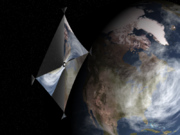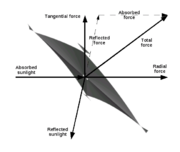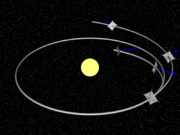Difference between revisions of "Solar Sailing 101"
m (→Why Don't Solar Sails Use the Solar Wind?) |
(→What are Solar Sails?) |
||
| (One intermediate revision by one user not shown) | |||
| Line 11: | Line 11: | ||
[[Image:WSFsailcraft_Earth.png|thumb|Square sail with steering vanes near Earth]] | [[Image:WSFsailcraft_Earth.png|thumb|Square sail with steering vanes near Earth]] | ||
| − | A solar sail is a large, lightweight mirror used to propel a spacecraft using the pressure exerted by sunlight. In essence, it works like a sailboat. Whereas a sailboat is propelled by deflecting the wind, a solar sail is propelled by deflecting sunlight. Solar pressure is very weak - about 9 millionths of a Newton (micro-Newtons) or 2 millionths of a pound (micro-pounds) of force on a square meter at Earth's distance from the sun. This is far too little pressure to have any effect on Earth, because other forces are much larger, like air drag and gravity driving us into the ground. In space there is no air | + | A solar sail is a large, lightweight mirror used to propel a spacecraft using the pressure exerted by sunlight. In essence, it works like a sailboat. Whereas a sailboat is propelled by deflecting the wind, a solar sail is propelled by deflecting sunlight. Solar pressure is very weak - about 9 millionths of a Newton (micro-Newtons) or 2 millionths of a pound (micro-pounds) of force on a square meter at Earth's distance from the sun. This is far too little pressure to have any effect on Earth, because other forces are much larger, like air drag and gravity driving us into the ground. In space there is no air and objects fall freely under the influence of gravity without the ground to constrain them. Sunlight can have a significant effect on objects, depending on how lightweight they are. Large and lightweight objects are affected more. Dust given off by comets is pushed into brilliant tails millions of kilometers long. Sunlight causes small errors to accumulate over time in spacecraft orbits and spin. Even asteroids gradually change their spin over millions of years. This gentle force is enough for a solar sail that is sufficiently large and light weight to travel between planets or change the behavior of its orbit around a planet or the sun - without consuming any propellant. |
*Also see: [[Solar Sail Design]] | *Also see: [[Solar Sail Design]] | ||
| Line 53: | Line 53: | ||
*Also see: [[Tacking Solar Sails]] | *Also see: [[Tacking Solar Sails]] | ||
| + | |||
| + | [[Category:Sailing]] | ||
Latest revision as of 15:26, 10 September 2010
Contents |
Introduction
Hopefully by reading this document, you will be able to answer these questions about solar sails:
- What is a solar sail?
- How does sunlight push a solar sail?
- How does a solar sail travel through space?
What are Solar Sails?
A solar sail is a large, lightweight mirror used to propel a spacecraft using the pressure exerted by sunlight. In essence, it works like a sailboat. Whereas a sailboat is propelled by deflecting the wind, a solar sail is propelled by deflecting sunlight. Solar pressure is very weak - about 9 millionths of a Newton (micro-Newtons) or 2 millionths of a pound (micro-pounds) of force on a square meter at Earth's distance from the sun. This is far too little pressure to have any effect on Earth, because other forces are much larger, like air drag and gravity driving us into the ground. In space there is no air and objects fall freely under the influence of gravity without the ground to constrain them. Sunlight can have a significant effect on objects, depending on how lightweight they are. Large and lightweight objects are affected more. Dust given off by comets is pushed into brilliant tails millions of kilometers long. Sunlight causes small errors to accumulate over time in spacecraft orbits and spin. Even asteroids gradually change their spin over millions of years. This gentle force is enough for a solar sail that is sufficiently large and light weight to travel between planets or change the behavior of its orbit around a planet or the sun - without consuming any propellant.
- Also see: Solar Sail Design
How Does Light Push a Solar Sail?
Light pressure was predicted in the late 1800s by James Clerk Maxwell using electromagnetism and Adolfo Bartoli using thermodynamics. It was first measured in 1900 by Peter Lebedev and 1901 by Ernest Nichols and Gordon Hull. Before then, the technology didn't exist to measure such a gentle force. Today, quantum mechanics and relativity can also be used to predict light pressure, and mission controllers deal every day with the subtle influence sunlight has on spacecraft.
Electromagnetism
The electromagnetic explanation begins with the description of sunlight as an electromagnetic wave. An oscillating electric field causes a perpendicular magnetic field to form, and vice versa. Together, this self-maintaining electromagnetic wave can travel through space, only losing energy or changing the frequency of oscillation by interaction with solid matter. When the wave is absorbed by a solid object, electric field theory predicts that the electric field will cause an electric current to flow in the surface of the material. Magnetic field theory predicts that the magnetic component of the light wave will exert a pressure into any material with a current flowing through it - just as a magnet pulls on a wire with a current. If the light wave is reflected from the object, the electric and magnetic fields will be in opposite directions as the originals, resulting in a force opposite the direction of the wave - that is, the same direction as the force from the original light wave. Thus, a mirrored object will experience twice the force of one that absorbs all the light.
Special Relativity
Einstein's theory of Special Relativity relates the energy (E) of particles to their mass (m) and momentum (p = mass × speed) by the following equation where c is the speed of light (299,792,458 meters/second):
- E2 = m2 c4 + p2 c2
If the particles have no momentum, then it reduces to the familiar E = m c2. Photons (light particles) have no mass, but they do have energy that is observed when sunlight warms your skin or generates power in a solar array. The equation becomes E = p c, which can be rearranged as p = E / c. Therefore, if you know how much energy there is in the sunlight absorbed and reflected by a solar sail over a period of time, you can calculate the momentum transferred to it. To find the change in speed, divide the momentum by the mass of the spacecraft.
At Earth's distance from the sun, sunlight has an intensity of ~1368 Watts per square meter (Joules per second per square meter). So, if a square meter object absorbs all that sunlight, its momentum will change by (1368 J) / (299,792,458 m/s) = 4.563×10-6 kg m/s2. If the sail also reflects the sunlight, its momentum will change again by the same amount, so the total momentum change will be 9.126×10-6 kg m/s2. That corresponds to a pressure of 9.126×10-6 N/m2 - about 9 micro-Newtons per square meter as stated previously.
Solar Wind
Many people assume that because here on Earth they feel wind but not sunlight, that solar sails must be pushed by the solar wind. However, there is a very big difference between space and Earth. Earth is wrapped in a thick layer of gas that is felt as wind whenever it moves. In space, there is no air to move around and cause strong winds like we feel on Earth. The solar wind is an extremely tenuous flow of particles ejected by the sun which exerts very little force on anything it hits. In fact, the solar wind can have 1000-10,000 times less force on a solar sail than sunlight. People worry about the solar wind for other reasons. Solar storms can hurt people and electronics in space. Increases in the solar wind can cause the upper atmosphere to swell and increase drag on low Earth orbit spacecraft. The solar wind can be used to push magnetic sail or plasma sail spacecraft.
Sailing
When a sail is pointed directly at the sun, it experiences a force as described above - the sun pushes the sail directly away from it at a force twice that of an object that absorbs the sunlight. The reflected light generates a reaction force as it leaves the sail, much like the exhaust of a rocket. When the sail is tilted at an angle to the sunlight, two things happen: less sunlight is intercepted by the sail and the forces from absorbed and reflected sunlight are no longer in the same direction. As the sail is tilted, the total force will drop until it becomes zero when the sail is edge-on to the sun. The absorbed sunlight and a portion of the reflected sunlight will always push directly away from the sun (called the radial force), but when the sail is tilted, there will be a portion of the reflected light that pushes perpendicular or tangent to the sunlight. This force component, called the tangential force, can be used to maneuver in space.
Sailing away from or towards the sun
Spacecraft normally coast in orbits around the sun or a planet. Rockets are used to apply a quick force to change the orbit to transfer to another area. Once reaching the new location, a second rocket burn places the spacecraft into the destination orbit. Solar sails, using the tangential force, can also change their orbits like a rocket. The difference is that the solar sail generates very low thrust that can run over the entire orbit transfer, rather than just a short powerful burst at either end. Instead of coasting to the destination, the sail gradually alters the orbit over time. Despite having a force component pushing away from the sun, the tangential force allows a sail to both travel towards and away from the sun. Like a rocket, if the tangential force is in the same direction as the spacecraft's orbit, the orbit will expand and the sail will travel out from the sun. If the sail is tilted the other direction so that the tangential force goes against the orbit, the orbit will contract and the sail will spiral in closer to the sun. This is able to overcome any complications caused by the portion of the force pushing out.
- Also see: Tacking Solar Sails



